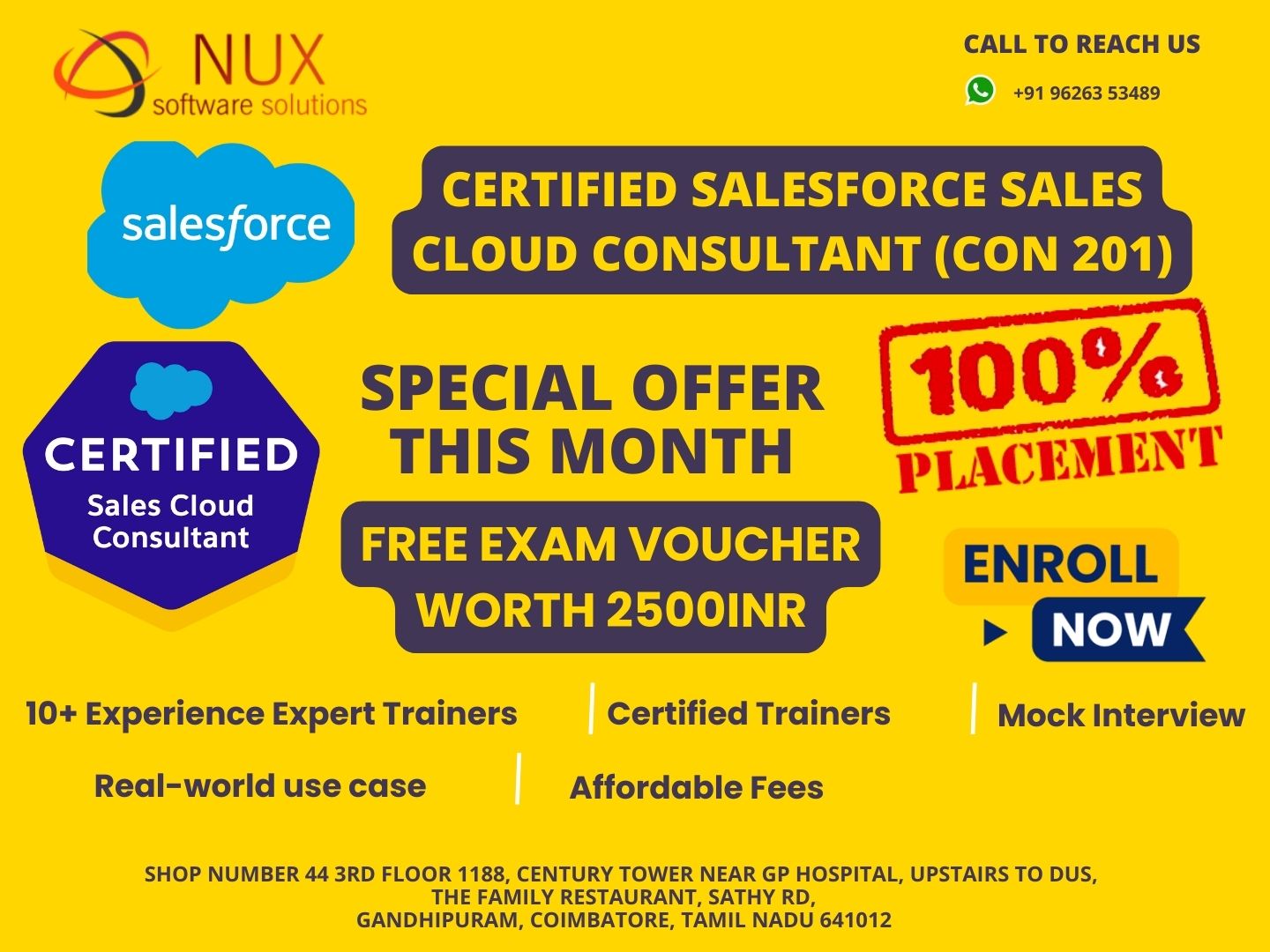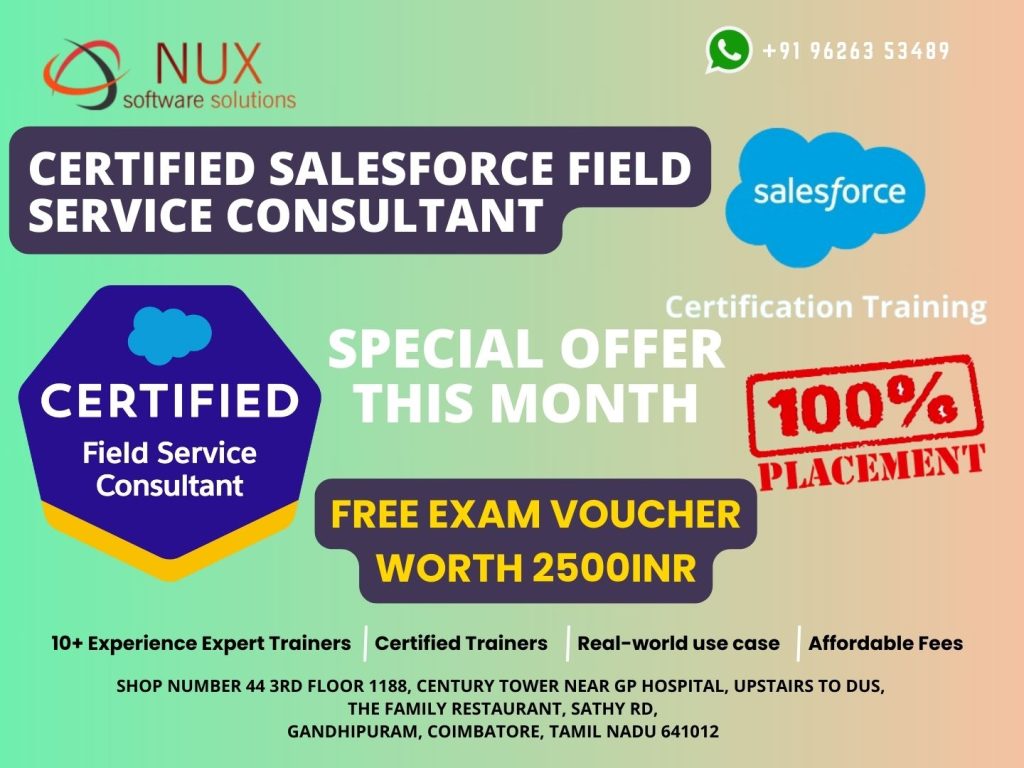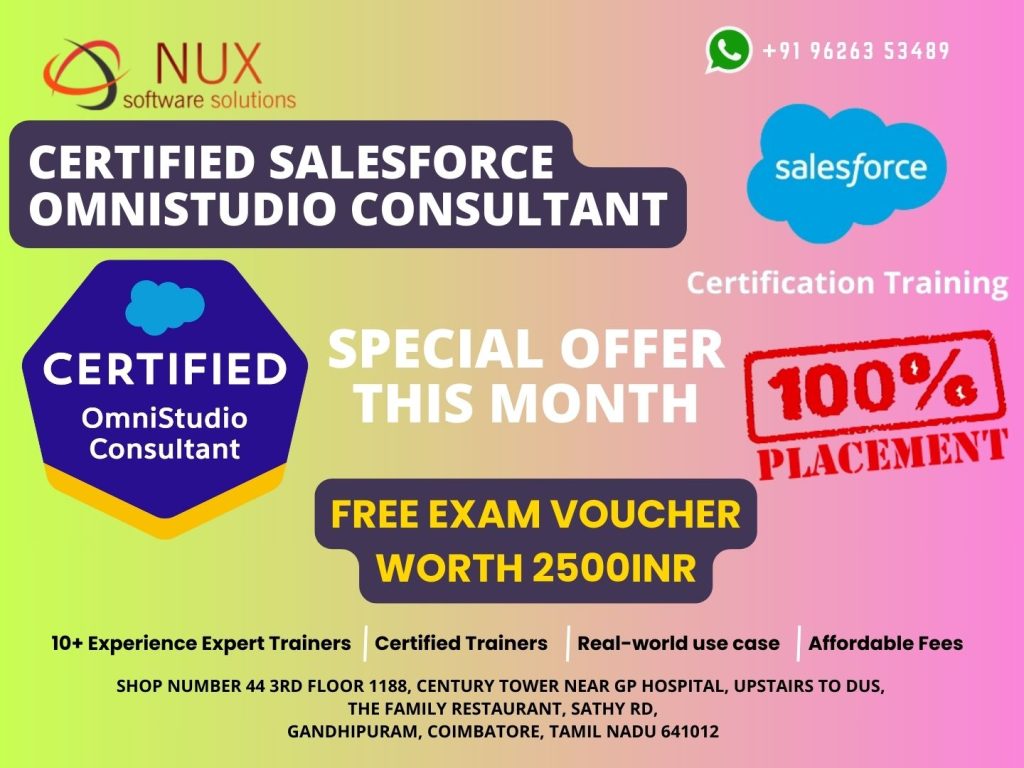Certified salesforce sales cloud consultant con-201 Training and certification in Coimbatore

Course Summary
The Salesforce Certified Sales Cloud Consultant certification validates your expertise in implementing Salesforce solutions that support sales processes, from lead management to forecasting and pipeline performance. This training equips consultants to design scalable solutions using Sales Cloud features such as Opportunity Management, Products, Quotes, Campaigns, and Sales Analytics.
Participants will learn how to gather requirements, map business needs to Salesforce capabilities, and deliver high-impact CRM solutions that drive revenue and sales productivity.
Why Choose This Course
Sales Cloud is Salesforce’s most widely adopted solution—and this course ensures you can implement it with excellence. You’ll learn to:
Prepare confidently for the Sales Cloud Consultant (CON-201) certification
Align sales process automation with real-world business models
Design systems that enhance team productivity, conversion rates, and forecasting
Lead projects for SMBs, enterprises, or Salesforce consulting partners
Gain practical consulting experience with Sales Cloud tools and use cases
Who Should Enroll
This course is ideal for:
Salesforce Admins or Consultants transitioning to solution design roles
Business analysts, CRM leads, or technical architects working with Sales Cloud
Professionals preparing for the Sales Cloud Consultant (CON-201 / CRT-251) exam
Sales operations managers seeking to optimize sales efficiency through CRM
Organizations adopting or customizing Salesforce Sales Cloud for revenue growth
Skills You Will Gain
Designing optimized sales processes with Leads, Opportunities, Products, and Price Books
Implementing features like Territory Management, Forecasting, and Quotes
Managing data quality, security, automation, and scalability within Sales Cloud
Aligning Salesforce configurations with KPI tracking and sales team structure
Consulting clients on pipeline visibility, performance analytics, and mobile CRM usage
Career Benefits
After completing this course, you will:
Be fully prepared for the Salesforce Certified Sales Cloud Consultant exam
Qualify for roles such as Salesforce Consultant, Sales Operations Lead, or CRM Business Analyst
Lead CRM implementation and optimization projects for B2B and B2C businesses
Gain recognition as a Salesforce expert who can drive revenue transformation
Increase your earning potential in a competitive, high-growth job market
Drive Sales Success with Salesforce Sales Cloud Expertise
Transform your understanding of sales strategy into Salesforce-powered solutions that scale. This certification sets you apart as a consultant who understands both business needs and platform capabilities.
Join the Sales Cloud Consultant training at Linux Training Center, Coimbatore.
Certified Salesforce Sales Cloud Consultant (CON 201) Syllabus
Modules
Introduction
Listing the features of Oracle Database 11g
Lesson 01
1.0 Salesforce Overview
1.1 Introduction to Salesforce
1.2 Salesforce Overview
1.3 Introduction to Salesforce
1.4 Salesforce Editions
1.5 Home Page Customization
1.6 User Management
1.7 Creating and Customizing Tabs
1.8 Creating an App
1.9 Uploading a Company Logo
1.10 Company Information Page
1.11 System Overview Page
1.12 Updating the Fiscal Year
1.13 Quiz
1.14 Case Study
1.15 Case Study Demo
1.16 Key Takeaways
1.17 Conclusion
Lesson 02
2.0 Sales Cloud
2.1 Introduction to Sales Cloud
2.2 Sales Cloud
2.3 Leads Home Page
2.4 Creating List Views
2.5 Creating and Converting Leads
2.6 Creating Accounts
2.7 Creating Contacts
2.8 Creating Email Templates
2.9 Sending Individual Emails
2.10 Sending Mass Emails
2.11 Creating and Managing Price Books
2.12 Creating Product
2.13 Creating Opportunities
2.14 Creating Activities
2.15 Creating a Web-to-Lead Form
2.16 Creating a Lead Assignment Rule
2.17 Creating a Lead Queue
2.18 Creating an Auto-Response Rule
2.19 Creating Campaigns
2.20 Record Types
2.21 Conclusion
Lesson 03
3.0 Quote Templates
3.1 Introduction to Quote Templates
3.2 Quote Templates
3.3 Creating a Quote Record
3.4 Creating a Quote Template
3.5 Generating a Quote PDf
3.6 Emailing a Quote PDF
3.7 Modifying Quote Templates
3.8 Conclusion
Lesson 04
4.0 Service Cloud
4.1 Introduction to Service Cloud
4.2 Service Cloud
4.3 Creating Cases
4.4 Creating Case Assignment Rules
4.5 Creating Case Escalation Rules
4.6 Enabling Solutions
4.7 Creating Solutions
4.8 Attaching Solutions to Cases
4.9 Enabling Knowledge
4.10 Configuring Knowledge
4.11 Creating a Web-to-Case Form
4.12 Creating an Email-to-Case Address
4.13 Conclusion
Lesson 05
5.0 AppExchange
5.1 Introduction to AppExchange
5.2 AppExchange
5.3 AppExchange Overview
5.4 Finding and Selecting an App
5.5 Finding a Developer
5.6 Finding a Consultant
5.7 Conclusion
Lesson 06
6.0 Reports
6.1 Introduction to Reports
6.2 Reports
6.3 Understanding Report Formats
6.4 Creating a Leads Report
6.5 Creating Contacts and Accounts Report
6.6 Creating an Opportunity Report
6.7 Adding Leads to a Campaign from a Report
6.8 Creating a Report Chart
6.9 Scheduling Reports
6.10 Creating a Campaign Report
6.11 Summarizing Report
6.12 Creating a Report Formula
6.13 Exporting Reports to Excel
6.14 Conclusion
Lesson 07
7.0 Dashboards
7.1 Introduction to Dashboards
7.2 Dashboards
7.3 Understanding Dashboard Components
7.4 Creating a Dashboard
7.5 Refreshing a Dashboard
7.6 Modifying Columns on Dashboards
7.7 Adding Filter to Dashboard
7.8 Managing Access to Reports
7.9 Adding a Report as a Dashboard Component
7.10 Setting Up Dynamic Dashboards
7.11 Enabling Dashboards for iPad
7.12 Modifying Report and Dashboard Interfaces
7.13 Activating the Report Builder on Profiles
7.14 Conclusion00:33
Lesson 08
8.0 Chatter and Salesforce to Salesforce Configuration
8.1 Introduction to Chatter
8.2 Chatter
8.3 Chatter Overview
8.4 Enabling Chatter
8.5 Enabling Chatter Feeds on Records
8.6 Configuring Chatter Groups
8.7 Creating Customer Groups
8.8 Creating a Free Customer Chatter User
8.9 Customizing Chatter Email Notifications
8.10 Configuring Salesforce to Salesforce
8.11 Accepting a Salesforce Connection
8.12 Sharing an Account via Salesforce to Salesforce
8.13 Enabling Ideas
8.14 Configuring Ideas Themes
8.15 Enabling Social Accounts
8.16 Enabling Libraries and Content
8.17 Customizing Libraries and Content
8.18 Uploading Documents to Libraries and Content
8.19 Configuring Salesforce
8.20 Conclusion
Lesson 09
9.0 Role Hierarchy
9.1 Introduction to Role Hierarchy
9.2 Role Hierarchy
9.3 Viewing Role Hierarchy
9.4 Creating Roles
9.5 Enabling Field History
9.6 Creating Groups
9.7 Creating Permission Sets
9.8 Assigning Roles to Users
9.9 Conclusion
Lesson 10
10.0 Security Controls
10.1 Introduction to Security Control
10.2 Security Control
10.3 Viewing Object Security
10.4 Changing Default Record Access
10.5 Sharing Settings
10.6 Field Accessibility
10.7 Password Policies
10.8 Session Settings
10.9 Login Flows
10.10 Network Access
10.11 Activations
10.12 Session Management
10.13 Login Access Policies
10.14 Certificate and Key Management
10.15 Viewing Setup Audit Trail
10.16 Executing Expire All Passwords
10.17 Delegated Administration
10.18 Remote Site Settings
10.19 Named Credentials
10.20 File Upload and Download Security
10.21 Conclusion
Lesson 11
11.0 Profiles
11.1 Introduction to Profiles
11.2 Profiles
11.3 Standard Profiles Overview
11.4 Assigning Page Layouts
11.5 Field-Level Security
11.6 Custom App Settings and Access
11.7 Tab Settings
11.8 Record Type Settings
11.9 Administrative Permission
11.10 General User Permissions
11.11 Standard Object Permissions
11.12 Custom Object Permissions
11.13 Password Policies and Session Timeout
11.14 Login Hours and IP Ranges
11.15 Enabling Apex and Visualforce Access
11.16 Quiz
11.17 Case Study
11.18 Case Study Demo
11.19 Key Takeaways
11.20 Conclusion
Lesson 12
12.0 Data Management
12.1 Introduction to Data Management
12.2 Data Management
12.3 Importing Leads
12.4 Importing Contacts and Accounts
12.5 Using Mass Delete
12.6 Installing Data Loader
12.7 Importing Records with Data Loader
12.8 Updating Records with Data Loader
12.9 Deleting Records with Data Loader
12.10 Exporting Records with Data Loader
12.11 Adding a Field in the Schema Builder
12.12 Scheduling a Data Export
12.13 Creating and Using Sandbox
12.14 Mass Transferring Records
12.15 Reporting Snapshots
12.16 Working with Tags
12.17 Conclusion



